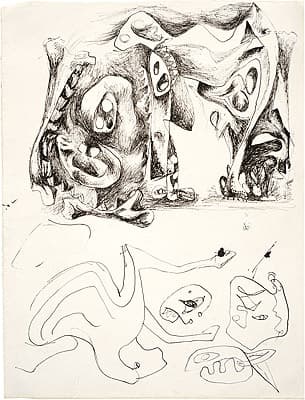
Jackson
POLLOCK
United States of America
1912
–
1956
Untitled
c.1943
pen and ink
on paper
OT 695
no inscriptions
sheet
33.6 (h)
x 25.4 (w)
cm
framed
58.5 (h)
x 43.2 (w)
cm
Purchased 1986
National Gallery of Australia, Canberra
NGA 1986.1051
© Pollock/Krasner Foundation/ARS. Licensed by Viscopy
- estate of the artist;
- estate of Lee Krasner Pollock;
- from whom bought, though Jason McCoy, New York on behalf of the Trustees of the Estate of Lee Krasner Pollock, by the Australian National Gallery, February 1986
- A Selection of European and American Watercolours and Drawings
- Marlborough - Gerson Gallery Inc.,
- MARLBOROUGH FINE ART (London) Ltd
- Marlborough Galerie
- Marlborough Galleria d'Arte, Rome
- Marlborough Gallery
- Jackson Pollock: Black and White
- Marlborough - Gerson Gallery Inc., 1969-03- – 1969-03-
- Jackson Pollock's Blue poles
- National Gallery of Australia 04 Oct 2002 – 27 Jan 2003
- Abstract Expressionism: the National Gallery of Australia celebrates the centenaries of Jackson Pollock and Morris Louis
- 14 Jul 2012 – 24 Feb 2013
- Dore Ashton, ‘New York commentary’, Studio International, May 1969, pp. 243–45, illus. b&w (image upside down);
- A selection of European and American watercolours and drawings, New York: Marlborough 1969 cat.162;
- Jackson Pollock: Black and white, New York: Marlborough 1969, cat.30;
- Eugene Thaw & Francis O'Connor, Jackson Pollock: Catalogue raisonné of paintings, drawings and other works, New Haven and London: Yale University Press, 1978, cat. 695, p. 205, illus. b&w (image upside down);
- Anthony White (ed.), Jackson Pollock’s Blue poles, Canberra: National Gallery of Australia 2002, cat. 22, p. 118, illus. b&w, p. 94
Pollock’s first New York exhibition was at the McMillan Gallery in 1942, where his work was shown alongside those of Pablo Picasso, Henri Matisse and Georges Braque. The curator of the exhibition was John D. Graham, who had written on Picasso and Jungian psychoanalysis. An identifiable source of stylistic inspiration for Pollock’s drawing is clearly the work of Picasso, in particular his Minotauromachie (Minotauromachy),an etching and engraving produced in 1935. The Surrealist biomorphic and linear forms of Joan Miró are also present in Pollock’s drawing, as is Jungian archetypical symbolism.
Pollock’s striking division of the composition into two distinct levels can be interpreted along Jungian lines. The top section—rendered in carefully shaded detail—may represent Jung’s ‘personal unconscious’, whilst the lower section—a loosely formed composition of lines and biomorphic shapes—may be seen to represent the deeper level of Jungian unconscious, the ‘collective unconscious’. It was this deeper level of the psyche from which Pollock and many of the Surrealists wished to draw their expressive imagery. In order to connect with their deepest psyche, a number of artists experimented with automatic drawing techniques, where they would suspend conscious control over their composition and allow the spontaneous movements of their subconscious to take over. As a collection of lightly executed curvilinear lines and separated organic shapes, the lower half of Pollock’s drawing appears to have been created using such an automatist technique.
Jaklyn Babington
As well as the two paintings by Pollock, Totem lesson 2 1945 and Blue poles 1952, the National Gallery of Australia holds six drawings from the 1930s and 1940s, and two sets of prints: six intaglio prints c.1944, printed 1967, and six screenprints 1950.
